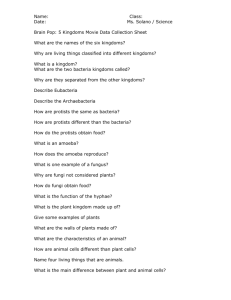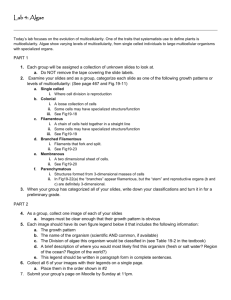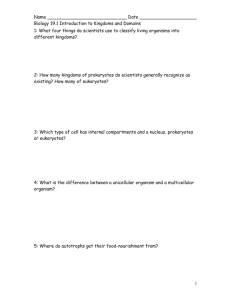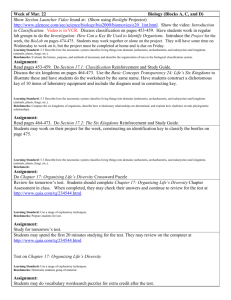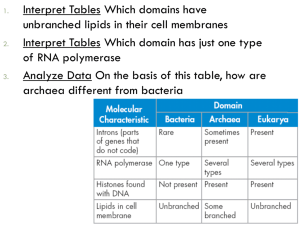Kinds of Archaebacteria
advertisement
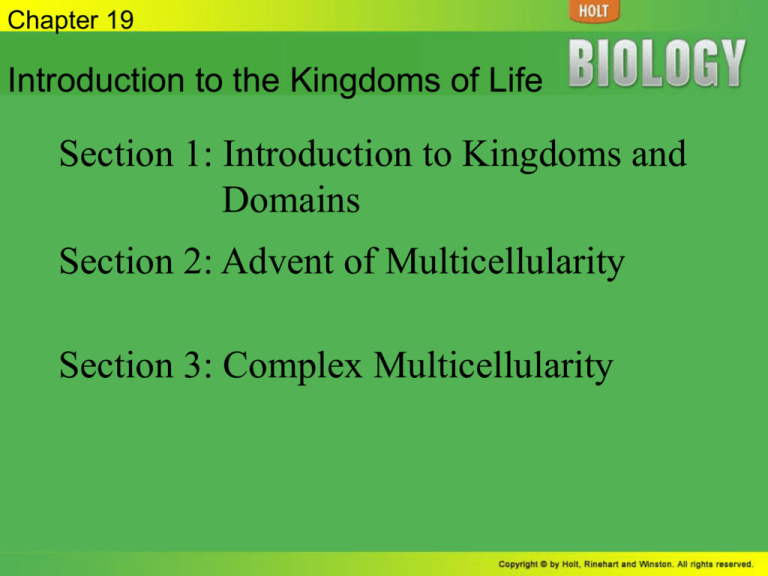
Chapter 19 Introduction to the Kingdoms of Life Section 1: Introduction to Kingdoms and Domains Section 2: Advent of Multicellularity Section 3: Complex Multicellularity Section 1 Introduction to Kingdoms and Domains Objectives: •Identify the characteristics used to classify kingdoms. •Differentiate bacteria from archaebacteria. Section 1 Introduction to Kingdoms and Domains The Six Kingdoms of Life •Kingdoms Members of the six kingdoms are grouped according to their cell type, cell complexity, body type, and nutrition. Section 1 Introduction to Kingdoms and Domains The Three Domains of Life •Domains Bacteria contain the kingdom Eubacteria, Archae contain the kingdom Archaebaceria, and Eukarya contain the kingdoms Animalia, Fungi, Plantae, and Protista. Section 1 Introduction to Kingdoms and Domains The Domain Bacteria •Characteristics of Bacteria Bacteria are classified according to their cell wall, gene structure, and gene translation apparatus. Bacteria are prokaryotes that have peptidoglycan in their cell wall and no introns in their genes. •Kinds of Bacteria Bacteria are heterotrophic or autotrophic. Section 1 Introduction to Kingdoms and Domains The Domain Archae •Characteristics of Archaebacteria Archaebacteria are classified according to their cell wall, cell membrane, gene structure, and gene translation apparatus. Archaebacteria are prokaryotes that have unusual lipids in their cell membrane, no peptidoglycan in their cell wall, and introns in their genes. •Kinds of Archaebacteria Methanogens, extremophiles (thermophiles and halophiles), and nonextreme archaebacteria are three types of archaebacteria. Section 1 Introduction to Kingdoms and Domains The Domain Eukarya •Characteristics of Eukarya Eukarya are classified based on cell interior, multicellularity, and sexual reproduction. •Kinds of Eukaryotes Four types of Eukaryotes include Animalia, Fungi, Plantae, and Protista. Section 2 Advent of Multicellularity Objectives: •Contrast the terms colony and aggregate. •List the characteristics of protists. •List the characteristics of fungi. Section 2 Advent of Multicellularity The Many Forms of Multicellularity •Colonies A colonial organism is a group of cells that live together permanently but do not coordinate most cell activity. •Aggregations Aggregations are collections of cells that come together for a limited period of time. •True Multicellularity Only eukaryotes exhibit true multicellularity, which occurs when the activities of the individual cells are coordinated and the cells are in contact with one another. Section 2 Advent of Multicellularity The Many Forms of Multicellularity continued •Complex Multicellularity Plants and animals show complex multicellularity, which occurs when specialized cells are organized into structures called tissues, organs, and organ systems. Section 2 Advent of Multicellularity Kingdom Protista •Kinds of Protists Protists include multicellular and unicellular eukaryotes and can be heterotrophs or autotrophs. Section 2 Advent of Multicellularity Kingdom Fungi •Kinds of Fungi Fungi are eukaryotic, and principally heterotrophs that exist mainly as slender hyphae. Section 3 Complex Multicellularity Objectives: •List the levels of cellular organization that occur in plants and animals. •Name the characteristics of plants. •Identify the characteristics of animals. •Differentiate plants from animals. Section 3 Complex Multicellularity Kingdom Plantae •Characteristics of Plants Plants are photosynthetic eukaryotes with tissue. Their cells have cell walls. They are the primary producers in most terrestrial food webs. They release oxygen and aid in resource cycling. •Kinds of Plants Plants differ according to the type of vascular tissue and reproductive structures. The types of plants include: nonvascular, seedless vascular, nonflowering seed plants, and flowering seed plants. Section 3 Complex Multicellularity Kingdom Animalia •Characteristics of Animals Animals are multicellular heterotrophs with cells that lack a cell wall, that are organized as tissues, and that are mostly diploid. They reproduce sexually, and their zygotes develop through several stages. •Kinds of Animals Animals include: sponges and cnidarians, mollusks, worms, arthropods, echinoderms, and vertebrates. •Ecological Roles Animals can fulfill various roles in an ecosystem including consumers and detrivores.
